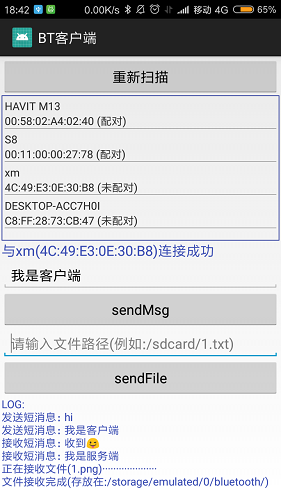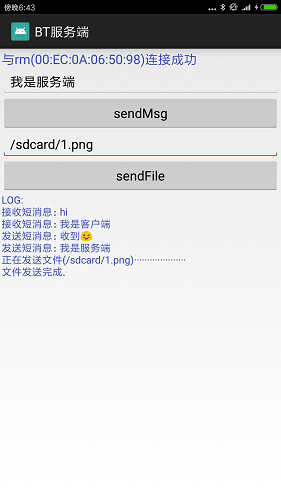参考:
https://developer.android.com/guide/topics/connectivity/bluetooth
http://bbs.eeworld.com.cn/thread-500972-1-1.html
一.蓝牙模块简介


从蓝牙4.0开始包含两个蓝牙芯片模块:传统/经典蓝牙模块(Classic Bluetooth,简称BT)和低功耗蓝牙(Bluetooth Low Energy,简称BLE)
经典蓝牙是在之前的蓝牙1.0,1.2,2.0+EDR,2.1+EDR,3.0+EDR等基础上发展和完善起来的, 而低功耗蓝牙是Nokia的Wibree标准上发展起来的,是完全不同两个标准。
1.经典蓝牙模块(BT)
泛指蓝牙4.0以下的模块,一般用于数据量比较大的传输,如:语音、音乐、较高数据量传输等。
经典蓝牙模块可再细分为:传统蓝牙模块和高速蓝牙模块。
传统蓝牙模块在2004年推出,主要代表是支持蓝牙2.1协议的模块,在智能手机爆发的时期得到广泛支持。
高速蓝牙模块在2009年推出,速率提高到约24Mbps,是传统蓝牙模块的八倍。
传统蓝牙有3个功率级别,Class1,Class2,Class3,分别支持100m,10m,1m的传输距离
2.低功耗蓝牙模块(BLE)
泛指蓝牙4.0或更高的模块,蓝牙低功耗技术是低成本、短距离、可互操作的鲁棒性无线技术,工作在免许可的2.4GHz ISM射频频段。
因为BLE技术采用非常快速的连接方式,因此平时可以处于“非连接”状态(节省能源),
此时链路两端相互间只是知晓对方,只有在必要时才开启链路,然后在尽可能短的时间内关闭链路(每次最多传输20字节)。
低功耗蓝牙无功率级别,一般发送功率在7dBm,一般在空旷距离,达到20m应该是没有问题
Android手机蓝牙4.x都是双模蓝牙(既有经典蓝牙也有低功耗蓝牙),而某些蓝牙设备为了省电是单模(只支持低功耗蓝牙)
开发者选经典蓝牙,还是BLE?(参考: http://baijiahao.baidu.com/s?id=1594727739470471520&wfr=spider&for=pc )
经典蓝牙:
1.传声音
如蓝牙耳机、蓝牙音箱。蓝牙设计的时候就是为了传声音的,所以是近距离的音频传输的不二选择。
现在也有基于WIFI的音频传输方案,例如Airplay等,但是WIFI功耗比蓝牙大很多,设备无法做到便携。
因此固定的音响有WIFI的,移动的如耳机、便携音箱清一色都是基于经典蓝牙协议的。
2.传大量数据
例如某些工控场景,使用Android或Linux主控,外挂蓝牙遥控设备的,
可以使用经典蓝牙里的SPP协议,当作一个无线串口使用。速度比BLE传输快多了。
这里要注意的是,iPhone没有开放
BLE蓝牙:
耗电低,数据量小,如遥控类(鼠标、键盘),传感设备(心跳带、血压计、温度传感器、共享单车锁、智能锁、防丢器、室内定位)
是目前手机和智能硬件通信的性价比最高的手段,直线距离约50米,一节5号电池能用一年,传输模组成本10块钱,远比WIFI、4G等大数据量的通信协议更实用。
虽然蓝牙距离近了点,但胜在直连手机,价格超便宜。以室内定位为例,商场每家门店挂个蓝牙beacon,
就可以对手机做到精度10米级的室内定位,一个beacon的价格也就几十块钱而已
双模蓝牙:
如智能电视遥控器、降噪耳机等。很多智能电视配的遥控器带有语音识别,需要用经典蓝牙才能传输声音。
而如果做复杂的按键,例如原本键盘表上没有的功能,经典蓝牙的HID按键协议就不行了,得用BLE做私有协议。
包括很多降噪耳机上通过APP来调节降噪效果,也是通过BLE来实现的私有通信协议。
- 1
- 2
- 3
- 4
- 5
- 6
- 7
- 8
- 9
- 10
- 11
- 12
- 13
- 14
- 15
- 16
- 17
- 18
- 19
- 20
- 21
- 22
- 23
- 24
- 25
- 26
- 27
- 28
- 29
- 30
- 31
- 32
- 33
- 34
- 35
- 36
- 37
- 38
- 39
二.Android 经典蓝牙(Classic Bluetooth)的API简介
本文介绍经典蓝牙,经典蓝牙适用于电池使用强度较大的操作,例如Android之间流式传输和通信等(音频/文件等大数据)。
从Android 4.3(API 18)才有API支持低功耗蓝牙(BLE),BLE相关API下篇再介绍。
经典蓝牙API如下:
android.bluetooth
.BluetoothA2dp 音频分发配置文件,高质量音频通过蓝牙连接和流式传输
.BluetoothAdapter 本地蓝牙适配器,是所有蓝牙交互的入口,发现设备,查询配对设备,创建BluetoothServerSocket侦听其他设备
.BluetoothAssignedNumbers
.BluetoothClass 描述蓝牙设备的一般特征和功能,这是一组只读属性,设备类型提示
.BluetoothDevice 远程蓝牙设备,与某个远程设备建立连接,查询设备信息,名称,地址,类和配对状态
.BluetoothHeadset 提供蓝牙耳机支持,以便与手机配合使用,蓝牙耳机和免提配置文件
.BluetoothHealth 控制蓝牙服务的健康设备配置文件代理
.BluetoothHealthAppConfiguration 第三方蓝牙健康应用注册的应用配置,以便与远程蓝牙健康设备通信
.BluetoothHealthCallback 实现 BluetoothHealth 回调的抽象类
.BluetoothManager
.BluetoothProfile 蓝牙配置文件,蓝牙通信的无线接口规范
.BluetoothServerSocket 服务端监听,连接RFCOMM通道(类似TCP ServerSocket)
.BluetoothSocket 建立RFCOMM通道,蓝牙Socket接口(类似TCP Socket),通过InputStream和OutputStream与其他设备传输数据
Android经典蓝牙的开发步骤如下:
1.扫描其他蓝牙设备
2.查询本地蓝牙适配器的配对蓝牙设备
3.建立 RFCOMM 通道 (SPP协议)
4.通过服务发现连接到其他设备
5.与其他设备进行双向数据传输
6.管理多个连接
RFCOMM是蓝牙简单传输协议, 在两个蓝牙设备间的一条物理链上提供多个模拟串口进行传输数据, 可同时保持高达60路的通信连接。
SPP(Serial Port Profile)是通过蓝牙设备之间的串口进行数据传输协议,spp协议处于RFCOMM上层,
如果能使用RFCOMM传输数据,就不需要使用SPP(省去一些流程,速度更快),但还是推荐用SPP,兼容性有保证
- 1
- 2
- 3
- 4
- 5
- 6
- 7
- 8
- 9
- 10
- 11
- 12
- 13
- 14
- 15
- 16
- 17
- 18
- 19
- 20
- 21
- 22
- 23
- 24
- 25
- 26
- 27
- 28
- 29
三.经典蓝牙-客户端和服务端建立长连接,传输短消息/文件
完整源码: https://github.com/lioilwin/Bluetooth
蓝牙耳机的音频传输也是采用这种长连接实现,我们可以通过广播监听连接状态


1.蓝牙权限和设置蓝牙
(1).在manifest中添加权限
<uses-permission android:name="android.permission.WRITE_EXTERNAL_STORAGE" />
<uses-permission android:name="android.permission.READ_EXTERNAL_STORAGE" />
<!--建立蓝牙连接和传输权限-->
<uses-permission android:name="android.permission.BLUETOOTH" />
<!--扫描蓝牙设备或修改蓝牙设置权限-->
<uses-permission android:name="android.permission.BLUETOOTH_ADMIN" />
<!--Android 6.0及后续版本扫描蓝牙,需要定位权限(进入GPS设置,可以看到蓝牙定位)-->
<uses-permission android:name="android.permission.ACCESS_COARSE_LOCATION" />
(2).在Activity中设置蓝牙
// 检查蓝牙开关
BluetoothAdapter adapter = BluetoothAdapter.getDefaultAdapter();
if (adapter == null) {
Util.toast(this, “本机没有找到蓝牙硬件或驱动!”);
finish();
return;
} else {
if (!adapter.isEnabled()) {
//直接开启蓝牙
adapter.enable();
//跳转到设置界面
//startActivityForResult(new Intent(BluetoothAdapter.ACTION_REQUEST_ENABLE), 112);
}
}
// Android 6.0动态请求权限
if (Build.VERSION.SDK_INT >= Build.VERSION_CODES.M) {
String[] permissions = {Manifest.permission.WRITE_EXTERNAL_STORAGE
, Manifest.permission.READ_EXTERNAL_STORAGE
, Manifest.permission.ACCESS_COARSE_LOCATION};
for (String str : permissions) {
if (checkSelfPermission(str) != PackageManager.PERMISSION_GRANTED) {
requestPermissions(permissions, 111);
break;
}
}
}
- 1
- 2
- 3
- 4
- 5
- 6
- 7
- 8
- 9
- 10
- 11
- 12
- 13
- 14
- 15
- 16
- 17
- 18
- 19
- 20
- 21
- 22
- 23
- 24
- 25
- 26
- 27
- 28
- 29
- 30
- 31
- 32
- 33
- 34
- 35
- 36
- 37
- 38
2.客户端-扫描经典蓝牙设备(不包含BLE蓝牙设备)
// 1.获取已配对设备
Set<BluetoothDevice> pairedDevices = mBluetoothAdapter.getBondedDevices();
List<BluetoothDevice> devices = new ArrayList<>();
devices.addAll(pairedDevices);
// 2.获取未配对设备
BroadcastReceiver mReceiver = new BroadcastReceiver() {
public void onReceive(Context context, Intent intent) {
String action = intent.getAction();
if (BluetoothDevice.ACTION_FOUND.equals(action)) {//获取未配对设备
BluetoothDevice device = intent.getParcelableExtra(BluetoothDevice.EXTRA_DEVICE);
devices.add(device);
}
}
};
registerReceiver(mReceiver, new IntentFilter(BluetoothDevice.ACTION_FOUND));
BluetoothAdapter.getDefaultAdapter().startDiscovery(); //开始扫描设备
- 1
- 2
- 3
- 4
- 5
- 6
- 7
- 8
- 9
- 10
- 11
- 12
- 13
- 14
- 15
- 16
- 17
3.客户端-建立连接
通用唯一标识符(UUID)是用于唯一标识信息的字符串ID的128位标准化格式,UUID足够庞大,不会发生冲突。
蓝牙MAC相当于TCP的IP,蓝牙UUID相当于TCP的端口,用于标识服务端蓝牙进程,
所以客户端和服务端两个UUID必须一致!
/**
-
客户端,与服务端建立长连接
*/
public class BtClient extends BtBase {
public BtClient(Listener listener) {
super(listener);
}/**
- 与远端设备建立长连接
- @param dev 远端设备
*/
public void connect(BluetoothDevice dev) {
close();
try {
// final BluetoothSocket socket = dev.createRfcommSocketToServiceRecord(SPP_UUID); //加密传输,Android强制执行配对,弹窗显示配对码
final BluetoothSocket socket = dev.createInsecureRfcommSocketToServiceRecord(SPP_UUID); //明文传输(不安全),无需配对
// 开启子线程
Util.EXECUTOR.execute(new Runnable() {
@Override
public void run() {
loopRead(socket); //循环读取
}
});
} catch (Throwable e) {
close();
}
}
}
- 1
- 2
- 3
- 4
- 5
- 6
- 7
- 8
- 9
- 10
- 11
- 12
- 13
- 14
- 15
- 16
- 17
- 18
- 19
- 20
- 21
- 22
- 23
- 24
- 25
- 26
- 27
- 28
- 29
- 30
- 31
- 32
- 33
4.服务端-监听连接
/** * 服务端监听和连接线程,只连接一个设备 */ public class BtServer extends BtBase { private static final String TAG = BtServer.class.getSimpleName(); private BluetoothServerSocket mSSocket;public BtServer(Listener listener) { super(listener); listen(); } /** * 监听客户端发起的连接 */ public void listen() { try { BluetoothAdapter adapter = BluetoothAdapter.getDefaultAdapter();
// mSSocket = adapter.listenUsingRfcommWithServiceRecord(TAG, SPP_UUID); //加密传输,Android强制执行配对,弹窗显示配对码
mSSocket = adapter.listenUsingInsecureRfcommWithServiceRecord(TAG, SPP_UUID); //明文传输(不安全),无需配对
// 开启子线程
Util.EXECUTOR.execute(new Runnable() {
@Override
public void run() {
try {
BluetoothSocket socket = mSSocket.accept(); // 监听连接
mSSocket.close(); // 关闭监听,只连接一个设备
loopRead(socket); // 循环读取
} catch (Throwable e) {
close();
}
}
});
} catch (Throwable e) {
close();
}
}
@Override
public void close() {
super.close();
try {
mSSocket.close();
} catch (Throwable e) {
e.printStackTrace();
}
}
}
- 1
- 2
- 3
- 4
- 5
- 6
- 7
- 8
- 9
- 10
- 11
- 12
- 13
- 14
- 15
- 16
- 17
- 18
- 19
- 20
- 21
- 22
- 23
- 24
- 25
- 26
- 27
- 28
- 29
- 30
- 31
- 32
- 33
- 34
- 35
- 36
- 37
- 38
- 39
- 40
- 41
- 42
- 43
- 44
- 45
- 46
- 47
- 48
5.客户端和服务端的基类,用于管理socket长连接,读写短消息/文件
public class BtBase { static final UUID SPP_UUID = UUID.fromString("00001101-0000-1000-8000-00805F9B34FB"); //自定义 private static final String FILE_PATH = Environment.getExternalStorageDirectory().getAbsolutePath() + "/bluetooth/"; private static final int FLAG_MSG = 0; //消息标记 private static final int FLAG_FILE = 1; //文件标记private BluetoothSocket mSocket; private DataOutputStream mOut; private Listener mListener; private boolean isRead; private boolean isSending; BtBase(Listener listener) { mListener = listener; } /** * 循环读取对方数据(若没有数据,则阻塞等待) */ void loopRead(BluetoothSocket socket) { mSocket = socket; try { if (!mSocket.isConnected()) mSocket.connect(); notifyUI(Listener.CONNECTED, mSocket.getRemoteDevice()); mOut = new DataOutputStream(mSocket.getOutputStream()); DataInputStream in = new DataInputStream(mSocket.getInputStream()); isRead = true; while (isRead) { //死循环读取 switch (in.readInt()) { case FLAG_MSG: //读取短消息 String msg = in.readUTF(); notifyUI(Listener.MSG, "接收短消息:" + msg); break; case FLAG_FILE: //读取文件 Util.mkdirs(FILE_PATH); String fileName = in.readUTF(); //文件名 long fileLen = in.readLong(); //文件长度 notifyUI(Listener.MSG, "正在接收文件(" + fileName + ")····················"); // 读取文件内容 long len = 0; int r; byte[] b = new byte[4 * 1024]; FileOutputStream out = new FileOutputStream(FILE_PATH + fileName); while ((r = in.read(b)) != -1) { out.write(b, 0, r); len += r; if (len >= fileLen) break; } notifyUI(Listener.MSG, "文件接收完成(存放在:" + FILE_PATH + ")"); break; } } } catch (Throwable e) { close(); } } /** * 发送短消息 */ public void sendMsg(String msg) { if (isSending || TextUtils.isEmpty(msg)) return; isSending = true; try { mOut.writeInt(FLAG_MSG); //消息标记 mOut.writeUTF(msg); } catch (Throwable e) { close(); } notifyUI(Listener.MSG, "发送短消息:" + msg); isSending = false; } /** * 发送文件 */ public void sendFile(final String filePath) { if (isSending || TextUtils.isEmpty(filePath)) return; isSending = true; Util.EXECUTOR.execute(new Runnable() { @Override public void run() { try { notifyUI(Listener.MSG, "正在发送文件(" + filePath + ")····················"); FileInputStream in = new FileInputStream(filePath); File file = new File(filePath); mOut.writeInt(FLAG_FILE); //文件标记 mOut.writeUTF(file.getName()); //文件名 mOut.writeLong(file.length()); //文件长度 int r; byte[] b = new byte[4 * 1024]; while ((r = in.read(b)) != -1) { mOut.write(b, 0, r); } notifyUI(Listener.MSG, "文件发送完成."); } catch (Throwable e) { close(); } isSending = false; } }); } /** * 关闭Socket连接 */ public void close() { try { isRead = false; mSocket.close(); notifyUI(Listener.DISCONNECTED, null); } catch (Throwable e) { e.printStackTrace(); } } /** * 当前设备与指定设备是否连接 */ public boolean isConnected(BluetoothDevice dev) { boolean connected = (mSocket != null && mSocket.isConnected()); if (dev == null) return connected; return connected && mSocket.getRemoteDevice().equals(dev); } // ============================================通知UI=========================================================== private void notifyUI(final int state, final Object obj) { MainAPP.runUi(new Runnable() { @Override public void run() { try { mListener.socketNotify(state, obj); } catch (Throwable e) { e.printStackTrace(); } } }); } public interface Listener { int DISCONNECTED = 0; int CONNECTED = 1; int MSG = 2; void socketNotify(int state, Object obj); }
}
- 1
- 2
- 3
- 4
- 5
- 6
- 7
- 8
- 9
- 10
- 11
- 12
- 13
- 14
- 15
- 16
- 17
- 18
- 19
- 20
- 21
- 22
- 23
- 24
- 25
- 26
- 27
- 28
- 29
- 30
- 31
- 32
- 33
- 34
- 35
- 36
- 37
- 38
- 39
- 40
- 41
- 42
- 43
- 44
- 45
- 46
- 47
- 48
- 49
- 50
- 51
- 52
- 53
- 54
- 55
- 56
- 57
- 58
- 59
- 60
- 61
- 62
- 63
- 64
- 65
- 66
- 67
- 68
- 69
- 70
- 71
- 72
- 73
- 74
- 75
- 76
- 77
- 78
- 79
- 80
- 81
- 82
- 83
- 84
- 85
- 86
- 87
- 88
- 89
- 90
- 91
- 92
- 93
- 94
- 95
- 96
- 97
- 98
- 99
- 100
- 101
- 102
- 103
- 104
- 105
- 106
- 107
- 108
- 109
- 110
- 111
- 112
- 113
- 114
- 115
- 116
- 117
- 118
- 119
- 120
- 121
- 122
- 123
- 124
- 125
- 126
- 127
- 128
- 129
- 130
- 131
- 132
- 133
- 134
- 135
- 136
- 137
- 138
- 139
- 140
- 141
- 142
- 143
- 144
- 145
- 146
- 147
- 148
- 149
- 150
- 151
- 152
简书: https://www.jianshu.com/p/977ab323c0a5
CSDN: https://blog.csdn.net/qq_32115439/article/details/80379262
GitHub博客: http://lioil.win/2018/05/19/Android-Bluetooth.html
Coding博客: http://c.lioil.win/2018/05/19/Android-Bluetooth.html
</div>





















 2万+
2万+

 被折叠的 条评论
为什么被折叠?
被折叠的 条评论
为什么被折叠?








